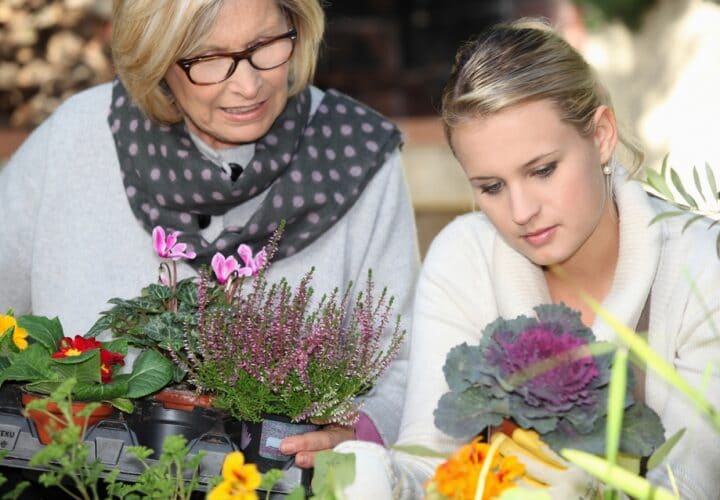As a dementia caregiver, you would have to be a superhero in order to do it all on your own. This step-by-step guide will help dementia caregivers pull a team together.
When a family member is first diagnosed with dementia, it may seem like involving other people in your family member’s care could only complicate matters. As Deidre Solon, who was a caregiver for her father after his Alzheimer’s diagnosis, once described it: “This house already seems like a three ring circus. Why would I want to add more clowns to the mix?”
While the task of putting together a team to offer caregiving help might seem daunting, caregiver stress is common, and when left unchecked, it can cause many problems of its own: Studies have found that caregiving — and more specifically, dementia caregiving — can wallop both mental health and physical health. It doesn’t have to be that way: Studies show that organized group caregiving — reaching for help outside your nuclear family unit — can lead to as much as an 83% decrease in experience of burden, meaning caregivers can hang on to the things that are important to them, friends and careers included.
Get the Lay of the Land
The first step in developing your caregiving team is to think through your current and future needs.
Ask yourself: What times of day are most difficult? What tasks and responsibilities are particularly difficult for you to squeeze in? What feels like it’s being perpetually left undone? Where in your life is caregiving most impacting you (e.g., career, relationships with children, etc.), and how does this happen?
Don’t worry yet about whether you’d let someone else take over any given responsibilities; we’re just getting it all on paper first: If you are having trouble teasing out the answers to these questions, ask a friend or family member to help you answer the questions with what they see through their eyes.
Suss Out Available Caregiving Help and Resources
Next, take stock of all the current resources that are available to you.
Start with professional resources: explain the situation to a social worker or case manager at the medical facility where your family member receives care, and ask if they can think of any other resources you are eligible to use.
Check out this guide to getting paid for your work as a family dementia caregiver.
Investigate Transportation Options
Often, large facilities have provisions for taxi vouchers to help with transportation to appointments. Some organizations even offer volunteers who help with transportation. Call your local aging office to ask what resources they may be able to provide And if you live in an area where public transit exists but is not easily accessible, the local transportation entity is required by law to provide alternative transportation for people with disabilities. Contact them and ask about what is needed in order to qualify for paratransit, which picks up and drops off patients at their exact destinations.
Ask Your Insurance Plan About In-Home Care
Your insurance company may provide some resources for in-home care: Double-check this directly by calling the toll-free number on the back of your insurance card.
If your loved one is not eligible for skilled nursing care or a nursing assistant, you may be able to negotiate to have a home health aide come for a few days a week, which Medicare may cover. This person cannot do as much hands-on care, but can help with safety monitoring, providing stimulation and conversation to your loved one, and even, possibly, light housekeeping.
If your insurance company deny the extra help, you usually have the right to appeal the decision: Get their denial in writing, and ask to speak to the next level supervisor. In addition, insurance companies often have high utilization patient care managers, who are tasked with preventing hospital readmissions. If you can make a case that having more help at home will lead to better outcome (and less bills for insurance to pay) they can often override an initial home care refusal.
Seek Out Volunteers to Help with Dementia Care
Local faith communities, health profession training schools, and certain student-based volunteer programs may be able to offer help from volunteers, or students who need college credit, to help a few hours a week.
If Friends and Family Have Offered Help, Take Them at Their Word
One of the cardinal rules of caregiving is that support comes from surprising places.
So, next, make a list of everyone who has said, “Let me know if there is anything I can do to help.” Don’t try to figure out now if their offer was made in earnest — people will surprise you.
Some folks might not have known to offer their skills, but could very well be interested in helping out with specific responsibilities. Think about any communities you or your loved one has been involved in, and any smaller groups within those communities (e.g., the choir of a church). Think about people who live close to you, coworkers or former coworkers, and any specific interest groups that have been a part of your life or your family member’s life over the years. Add those names to the list.
Put the Pieces of Your Caregiving Team in Place
Now, look at your list of hard times/places/difficult tasks and consider: Is there anyone on your list who seems like a good fit between the help you need and the help they could give? Some obvious pairings will appear.
For example, perhaps it’s very difficult to get your young children dinner on the days you take your family member to medical appointments, and meanwhile, you have a friend who is a creative cook. Could they bake and freeze a few casseroles for your freezer? Or maybe you have a friend who loves to drive and enjoys your kids; they could take them to school on appointment days.
Matching abilities and tasks skillfully also entails considerations of your friends’ and family members’ personalities and quirks; your musician friend who is rarely up before noon probably shouldn’t help you with early morning appointments, but they might just the person to call if you need a ride to the ER late at night.
Are You Adding Your Own Needs to the List?
Don’t stop with addressing the needs of your family member. Think about your needs as well; one quarter of all family caregivers of patients with dementia report delaying their own healthcare. Looking out for yourself, your health and your sanity are all part of the task at hand.
Get Your Family Member on Board
Now, consider the family member you are caring for. In order to make transitions easy, and cut confusion or resistance off at the chase, make sure that — as much as possible — the subject of your care is part of the decision-making process.
Explain that it’s important for you to be able to continue to provide them whatever help they need, and that getting help for you will ensure this. At first you’ll want to focus on small, specific, non-intimate logistical responsibilities that support you as a caregiver and your entire family unit: rides, help with meals, help with childcare, assistance with paperwork and advocacy.
It’s natural at this point to feel some internal resistance as well; it’s hard to invite people into a private, painful and emotionally messy part of your life.
But taking on all aspects of dementia caregiving can be extremely draining and finding help is often the only way to ensure sustainability. It might help to remind yourself that people want to help, and that you’re actually doing them a favor by giving them some real guidance about what you most need, and how their skills and gifts can lighten the load for your family.
Even just providing peer support or listening to you vent can have long term positive impact on your experience of caregiving.
After You Try It Out, Iterate
Once you’ve tried letting more folks onto your team, you can do some troubleshooting. What worked? What didn’t? What changes need to be made?
Then, consider automating or formalizing your team a bit. You can use a text or phone tree, or an online shared calendar. If most folks in your group are tech savvy, you can use one of the websites or apps created for this purpose, such as Lotsa Helping Hands, CaringBridge or CareZone.
When time and energy are scarce, taking the initial steps to start a caregiving team might seem impossible. But if you start slowly and troubleshoot the process as you go, it’s a valuable investment in providing your very best, sustainable care to your loved one.
Additional writing and reporting by the Being Patient reporting team.




